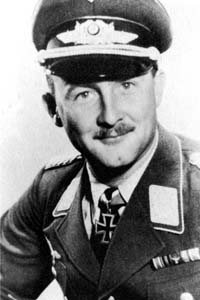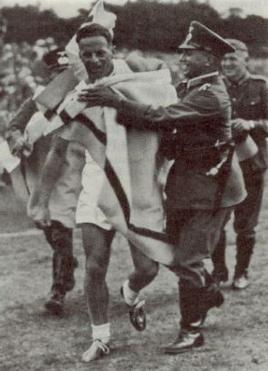
Wolfgang Schellmann was a German Luftwaffe military aviator during the Spanish Civil War and World War II. As a fighter ace, he is credited with 25 enemy aircraft shot down, including 12 in Spain, 12 on the Western Front and one on the Eastern Front of World War II.

Gotthard Handrick was a German Olympic athlete and German fighter pilot during the Spanish Civil War and World War II.

Erich Leie was a German Luftwaffe military aviator and wing commander during World War II. As a fighter ace, he is credited with 121 aerial victories claimed in more than 500 combat missions. He claimed 44 on Western Front, 77 on the Eastern Front, including one four-engine bomber.
Dr. Peter Werfft-Wessely, an Austrian chemist, was a Luftwaffe fighter ace in World War II, and a chemical industry entrepreneur after the war. He was also a recipient of the Knight's Cross of the Iron Cross. The Knight's Cross of the Iron Cross was awarded to recognise extreme battlefield bravery or successful military leadership.
Bernhard Woldenga was a German pilot during World War II. He served in the Luftwaffe, commanding the JG 27 and JG 77 fighter wings. Woldenga was a recipient of the Knight's Cross of the Iron Cross of Nazi Germany.
Anton Mader was a German pilot during World War II. He claimed 86 victories and was a recipient of the Knight's Cross of the Iron Cross. He commanded the fighter wing Jagdgeschwader 54 in 1944.
Carl-Alfred (August) Schumacher was a German military officer and politician. During World War II, Schumacher served in the German Luftwaffe, commanding the Jagdgeschwader 1 fighter wing. After World War II, Schumacher was an active politician and member of the All-German Bloc/League of Expellees and Deprived of Rights (GB/BHE), German Party (DP) and Christian Democratic Union of Germany (CDU). From 1952 to 1963, he was an elected member of the Landtag in Lower Saxony.
Franz Barten was a World War II fighter ace from Germany. He was born on 26 January 1912 at Saarbrücken. Barten was credited with having shot down a total of 52 Allied aircraft.

Hartmann Grasser was a World War II German fighter ace. He was credited with shooting down 103 Allied aircraft while flying 700 missions on the Western Front, Eastern Front, and in North Africa. He was also a recipient of the Knight's Cross of the Iron Cross with Oak Leaves.
Rudolf Pflanz was a German Luftwaffe fighter pilot and recipient of the Knight's Cross of the Iron Cross during World War II. Pflanz claimed 52 aerial victories, all of them over the Western Front.
Emil Omert was a German Luftwaffe ace and recipient of the Knight's Cross of the Iron Cross during World War II. Omert claimed 70 aerial victories in over 700 missions, including 125 fighter-bomber and ground attack mission. He also claimed 25 aircraft destroyed on the ground. Emil Omert was awarded the Knight's Cross on 19 March 1942 for 50 victories. The Knight's Cross of the Iron Cross was awarded to recognise extreme battlefield bravery or successful military leadership.
Ernst Börngen was a Luftwaffe ace and recipient of the Knight's Cross of the Iron Cross during World War II. The Knight's Cross of the Iron Cross was awarded to recognise extreme battlefield bravery or successful military leadership. Börngen claimed 41 victories in 450 missions.
Walter Brandt was a German Luftwaffe ace and recipient of the Knight's Cross of the Iron Cross during World War II. The Knight's Cross of the Iron Cross was awarded to recognise extreme battlefield bravery or successful military leadership. Brandt was credited with 43 aerial victories in 527 missions.
Karl-Heinz Krahl was a Luftwaffe ace and recipient of the Knight's Cross of the Iron Cross during World War II. The Knight's Cross of the Iron Cross was awarded to recognise extreme battlefield bravery or successful military leadership. Karl-Heinz Krahl was shot down 14 April 1942, by anti-aircraft fire from the defenses at RAF Luqa during the Siege of Malta. During his career he is credited with between 19 - 24 aerial victories, all against Western forces.
Karl-Heinz Leesmann was a Luftwaffe ace and recipient of the Knight's Cross of the Iron Cross during World War II. The Knight's Cross of the Iron Cross was awarded to recognise extreme battlefield bravery or successful military leadership. Karl-Heinz Leesmann was shot down on 25 July 1943, by a B-17 bomber that he was attacking. During his career he was credited with 37 aerial victories, 27 on the Western Front and 10 on the Eastern Front.
Franz Beyer was a German Luftwaffe fighter pilot during World War II and a recipient of the Knight's Cross of the Iron Cross of Nazi Germany. Beyer was killed on 11 February near Venlo, the Netherlands after dog-fighting with British Spitfires. During his career he was credited with 83 aerial victories, 6 on the Western Front and 77 on the Eastern Front. On 1 June 1943, Beyer was appointed Gruppenkommandeur of IV. Gruppe of Jagdgeschwader 3.
Max Bucholz was a German Luftwaffe ace and recipient of the Knight's Cross of the Iron Cross during World War II. Bucholz was credited with between 28 and 30 victories, including an ace in a day.
Hans von Hahn was a Luftwaffe ace and recipient of the Knight's Cross of the Iron Cross during World War II. The Knight's Cross of the Iron Cross was awarded to recognise extreme battlefield bravery or successful military leadership. During his career he was credited with 34 aerial victories, 15 on the Western Front and 19 on the Eastern Front.
Karl-Heinz Langer was a Luftwaffe ace and recipient of the Knight's Cross of the Iron Cross during World War II. The Knight's Cross of the Iron Cross was awarded to recognise extreme battlefield bravery or successful military leadership. During his career he was credited with 30 aerial victories in 486 missions, 10 on the Western Front and 20 on the Eastern Front.
Josef Haiböck was a general in the Austrian Air Force. During World War II, he served as a fighter pilot in the Luftwaffe of Nazi Germany and was a recipient of the Knight's Cross of the Iron Cross. Haiböck joined the Austrian Austrian Armed Forces (Budensheer) in 1956 and retired in 1977 as a Generalmajor. During his career he was credited with 77 aerial victories in 604 missions.




